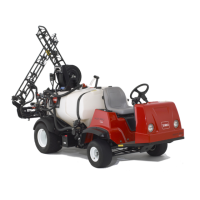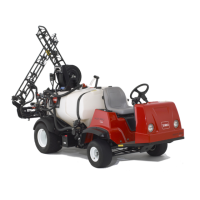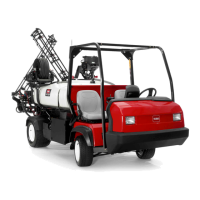Multi Pro 1200/1250Chassis Page 8 -- 16
Brake Master Cylinder Service
Testing
1. Insure that brake system is properly adjusted and
bled.
2. Apply light pressure to brake pedal.
3. Ifbrakepedalfadesorfalls awaywhileapplyinglight
pressure to pedal, the master cylinder should be s er-
viced.
Disassembly (Fig. 13)
1. Remove reservoir and flange seal. Push in on the
push rod so the stop pin can be removed.
2. Disconnect lower end of the dust cover from the
housing.
3. Push in on the push rod and remove circlip, then re-
move push rod with dust cover and clevis. Remove re-
tainer washer.
4. Remove primary piston assembly and secondary
piston assembly from cylinder housing.
Inspection
1. Clean all metal parts with isopropyl alcohol, then
clean out and dry grooves and passageways w ith com-
pressed air. Make s ure cylinder bore and component
pieces are thoroughly clean.
2. Checkcylinderbore,pistonsandspringsfordamage
or excessive wear. Replace brake cylinder assembly if
signs ofpitting,scoringorcracks areevidentincylinder
bore. Note: Do not hone bore of brake cylinder.
Assembly (Fig. 13)
1. Apply a film of clean brake fluid to cylinder bore and
piston assemblies.
2. Install secondary piston assembly and primary pis-
ton assembly into cylinder.
3. Install retainer washer.
4. Install push rod and secure in place with c irclip.
Install lower end of dust cover to housing.
5. Push in on push rod so stop pin can be installed to
retain secondary piston assembly, then install flange
seal and reservoir.
1. Reservoir
2. Flange seal
3. Stop pin
4. Secondary piston assy
5. Clevis
6. Jam nut
7. Dust cover
8. Push rod
9. Circlip
10. Retainer washer
11. Primary piston assy
12. Cylinder housing
Figure 13
12
1
2
3
4
5
6
7
8
9
10
11

